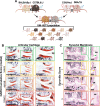Development of primary osteoarthritis during aging in genetically diverse UM-HET3 mice
- PMID: 38851726
- PMCID: PMC11161968
- DOI: 10.1186/s13075-024-03349-y
Development of primary osteoarthritis during aging in genetically diverse UM-HET3 mice
Abstract
Background: Primary osteoarthritis (OA) occurs without identifiable underlying causes such as previous injuries or specific medical conditions. Age is a major contributing factor to OA, and as one ages, various joint tissues undergo gradual change, including degeneration of the articular cartilage, alterations in subchondral bone (SCB) morphology, and inflammation of the synovium.
Methods: We investigated the prevalence of primary OA in aged, genetically diverse UM-HET3 mice. Articular cartilage (AC) integrity and SCB morphology were assessed in 182 knee joints of 22-25 months old mice using the Osteoarthritis Research Society International (OARSI) scoring system and micro-CT, respectively. Additionally, we explored the effects of methylene blue (MB) and mitoquinone (MitoQ), two agents that affect mitochondrial function, on the prevalence and progression of OA during aging.
Results: Aged UM-HET3 mice showed a high prevalence of primary OA in both sexes. Significant positive correlations were found between cumulative AC (cAC) scores and synovitis in both sexes, and osteophyte formation in female mice. Ectopic chondrogenesis did not show significant correlations with cAC scores. Significant direct correlations were found between AC scores and inflammatory markers in chondrocytes, including matrix metalloproteinase-13, inducible nitric oxide synthase, and the NLR family pyrin domain containing-3 inflammasome in both sexes, indicating a link between OA severity and inflammation. Additionally, markers of cell cycle arrest, such as p16 and β-galactosidase, also correlated with AC scores. In male mice, no significant correlations were found between SCB morphology traits and cAC scores, while in female mice, significant correlations were found between cAC scores and tibial SCB plate bone mineral density. Notably, MB and MitoQ treatments influenced the disease's progression in a sex-specific manner. MB treatment significantly reduced cAC scores at the medial knee joint, while MitoQ treatment reduced cAC scores, but these did not reach significance.
Conclusions: Our study provides comprehensive insights into the prevalence and progression of primary OA in aged UM-HET3 mice, highlighting the sex-specific effects of MB and MitoQ treatments. The correlations between AC scores and various pathological factors underscore the multifaceted nature of OA and its association with inflammation and subchondral bone changes.
Keywords: Antioxidants; Cartilage; Methylene blue; Mitoquinone; Osteoarthritis; Sub-chondral bone; UM-HET3.
© 2024. The Author(s).
Conflict of interest statement
The authors declare no competing interests.
Figures





Update of
-
Development of primary osteoarthritis during aging in genetically diverse UM-HET3 mice.bioRxiv [Preprint]. 2024 Jan 14:2023.12.16.571693. doi: 10.1101/2023.12.16.571693. bioRxiv. 2024. Update in: Arthritis Res Ther. 2024 Jun 8;26(1):118. doi: 10.1186/s13075-024-03349-y. PMID: 38168298 Free PMC article. Updated. Preprint.
-
Development of primary osteoarthritis during aging in genetically diverse UM-HET3 mice.Res Sq [Preprint]. 2024 Jan 22:rs.3.rs-3858256. doi: 10.21203/rs.3.rs-3858256/v1. Res Sq. 2024. Update in: Arthritis Res Ther. 2024 Jun 8;26(1):118. doi: 10.1186/s13075-024-03349-y. PMID: 38343826 Free PMC article. Updated. Preprint.
Similar articles
-
Development of primary osteoarthritis during aging in genetically diverse UM-HET3 mice.Res Sq [Preprint]. 2024 Jan 22:rs.3.rs-3858256. doi: 10.21203/rs.3.rs-3858256/v1. Res Sq. 2024. Update in: Arthritis Res Ther. 2024 Jun 8;26(1):118. doi: 10.1186/s13075-024-03349-y. PMID: 38343826 Free PMC article. Updated. Preprint.
-
Development of primary osteoarthritis during aging in genetically diverse UM-HET3 mice.bioRxiv [Preprint]. 2024 Jan 14:2023.12.16.571693. doi: 10.1101/2023.12.16.571693. bioRxiv. 2024. Update in: Arthritis Res Ther. 2024 Jun 8;26(1):118. doi: 10.1186/s13075-024-03349-y. PMID: 38168298 Free PMC article. Updated. Preprint.
-
Targeting mitochondrial dysfunction using methylene blue or mitoquinone to improve skeletal aging.Aging (Albany NY). 2024 Mar 25;16(6):4948-4964. doi: 10.18632/aging.205147. Epub 2024 Mar 25. Aging (Albany NY). 2024. PMID: 38535998 Free PMC article.
-
Molecular regulation of articular chondrocyte function and its significance in osteoarthritis.Histol Histopathol. 2011 Mar;26(3):377-94. doi: 10.14670/HH-26.377. Histol Histopathol. 2011. PMID: 21210351 Review.
-
Skeletal Muscle Wasting and Its Relationship With Osteoarthritis: a Mini-Review of Mechanisms and Current Interventions.Curr Rheumatol Rep. 2019 Jun 15;21(8):40. doi: 10.1007/s11926-019-0839-4. Curr Rheumatol Rep. 2019. PMID: 31203463 Free PMC article. Review.
Cited by
-
Osteoarthritis as an evolutionary legacy: Biological ageing and chondrocyte hypertrophy.Osteoarthr Cartil Open. 2025 May 13;7(3):100624. doi: 10.1016/j.ocarto.2025.100624. eCollection 2025 Sep. Osteoarthr Cartil Open. 2025. PMID: 40492024 Free PMC article. Review.
-
Animal models for age-related osteoporosis.Gerontology. 2025 May 20:1-29. doi: 10.1159/000546107. Online ahead of print. Gerontology. 2025. PMID: 40418907 Free PMC article. Review.
-
Targeting Cellular Senescence: Pathophysiology in Multisystem Age-Related Diseases.Biomedicines. 2025 Jul 15;13(7):1727. doi: 10.3390/biomedicines13071727. Biomedicines. 2025. PMID: 40722797 Free PMC article. Review.
-
Advances in Molecular Research on Hip Joint Impingement-A Vascular Perspective.Biomolecules. 2024 Jun 30;14(7):784. doi: 10.3390/biom14070784. Biomolecules. 2024. PMID: 39062498 Free PMC article. Review.
-
Characterization of craniofacial tissue aging in genetically diverse HET3 male mice with longevity treatment of 17-alpha estradiol.Arch Oral Biol. 2025 Mar;171:106170. doi: 10.1016/j.archoralbio.2024.106170. Epub 2024 Dec 27. Arch Oral Biol. 2025. PMID: 39742550
References
-
- Mobasheri A, et al. Glucose transport and metabolism in chondrocytes: a key to understanding chondrogenesis, skeletal development and cartilage degradation in osteoarthritis. Histol Histopathol. 2002;17(4):1239–67. - PubMed
MeSH terms
Substances
Grants and funding
LinkOut - more resources
Full Text Sources
Medical
Miscellaneous

